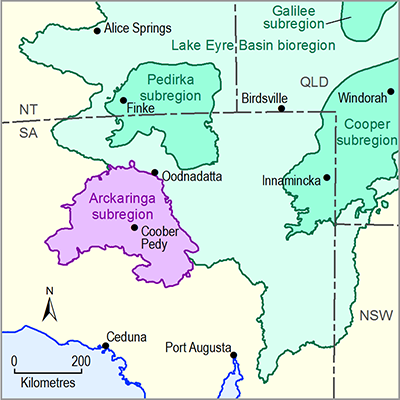- Home
- Assessments
- Bioregional Assessment Program
- Arckaringa subregion
- 1.1 Context statement for the Arckaringa subregion
- 1.1.4 Hydrogeology and groundwater quality
Summary
A lack of data throughout the Arckaringa Basin limits our understanding concerning groundwater characteristics, with most information about groundwater within the Arckaringa Basin relating to the south-east corner.
Within the Arckaringa Basin, the Stuart Range Formation is characterised as confining layers and the Mount Toondina and Boorthanna formations as aquifers. That being said, interbeds of finer grained sediments within aquifer units and the formation of secondary porosity are important considerations. The separation of the Mount Toondina and Boorthanna formations by the Stuart Range Formation may lead to the existence of two regionally extensive aquifers that have determinably different hydrodynamics and flow characteristics. Groundwater from Arckaringa Basin aquifers is generally described as brackish to ultra-saline, although fresh supplies are known to occur. The recharge and discharge characteristics of the Arckaringa Basin are generally poorly understood. Recharge via diffuse discharge from the main GAB aquifer (JK aquifer), direct recharge near the southern basin margin and from freshwater stream and wetland environments have all been proposed. The most commonly proposed discharge mechanisms are direct discharge into the neighbouring Stuart Shelf along the south-eastern margin of the basin or into salt pan (salina) environments near the western margin of the basin. Currently, an important use of groundwater resources within the Arckaringa Basin is mining-related abstraction from the south-east corner near Prominent Hill; although no adverse impacts to the overlying GAB aquifer have been reported to date.
Groundwater within the Cenozoic, Officer Basin and fractured rock aquifers is typically very saline; consequently, these groundwaters have limited use. In contrast, good quality groundwater within the GAB is the most widely known and utilised groundwater resource in the vicinity of the Arckaringa subregion. Although there are a number of aquifer units within the GAB, the most important with respect to utilisation are the Cadna-owie Formation and Algebuckina Sandstone (and lateral equivalents). Current research suggests that diffuse recharge to the GAB along the western margin is currently minimal and major recharge events are linked to wetter climate periods. Periodic river flow events may have localised and regional importance. Discharge from the GAB occurs via direct discharge at springs or via diffuse discharge through confining layers, although such discharge is likely to only be meaningful where the confining layers have been deformed by faulting. Cenozoic aquifers are likely to be recharged via diffuse or focused recharge following large rainfall events and upward leakage through confining layers. Discharge occurs into localised wetlands or is driven by evapotranspiration. Recharge to Officer Basin aquifers occurs via old river channels or associated with Officer Basin outcrop near the Everard Ranges, while salt lakes along of the Officer Basin’s southern margin provide the only evidence for discharge. Recharge to fractured rock aquifers is inferred to occur either by direct infiltration or via river channels that incise basement rock.

Product Finalisation date
- 1.1.1 Bioregion
- 1.1.2 Geography
- 1.1.3 Geology
- 1.1.4 Hydrogeology and groundwater quality
- 1.1.5 Surface water hydrology and surface water quality
- 1.1.6 Surface water – groundwater interactions
- 1.1.7 Ecology
- Citation
- Acknowledgements
- Contributors from the Government of South Australia
- Contributors to the Technical Programme
- About this technical product
